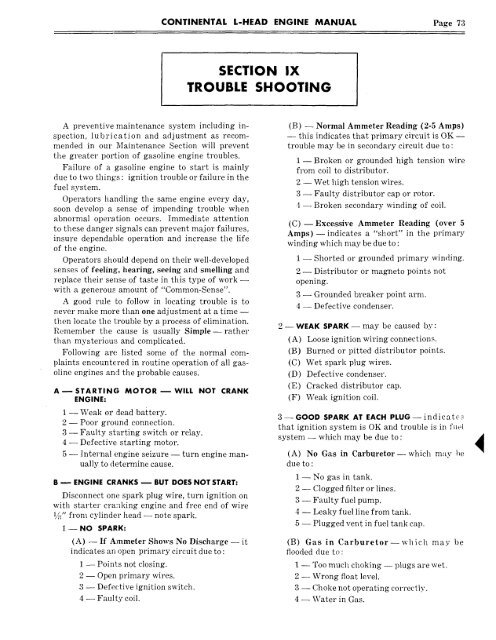Continental L-Head Overhaul Manual - Igor Chudov
Continental L-Head Overhaul Manual - Igor Chudov
Continental L-Head Overhaul Manual - Igor Chudov
You also want an ePaper? Increase the reach of your titles
YUMPU automatically turns print PDFs into web optimized ePapers that Google loves.
A preventive maintenance system including inspection,<br />
lubrication and adjustment as recommended<br />
in our Maintenance Section will prevent<br />
the greater portion of gasoline engine troubles.<br />
Failure of a gasoline engine to start is mainly<br />
due to two things : ignition trouble or failure in the<br />
fuel system.<br />
Operators handling the same engine every day,<br />
soon develop a sense of impending trouble when<br />
abnormal operation occurs. Immediate attention<br />
to these danger signals can prevent major failures,<br />
insure dependable operation and increase the life<br />
of the engine.<br />
Operators should depend on their well-developed<br />
senses of feeling, hearing, seeing and smelling and<br />
replace their sense of taste in this type of work -with<br />
a generous amount of "Common-Sense".<br />
A good rule ~o follow in locating trouble is to<br />
never make more than one adjustment at a time -then<br />
locate the trouble by a process of elimination.<br />
Remember the cause is usually Simple--rather<br />
than mysterious and complicated.<br />
Following are listed some of the normal complaints<br />
encountered in routine operation of all gasoline<br />
engines and the probable causes.<br />
A~STARTING MOTOR--WILL NOT CRANK<br />
ENGINE:<br />
1 --Weak or dead battery.<br />
2 -- Poor ground connection.<br />
3 -- Faulty starting switch or relay.<br />
4 -- Defective starting motor.<br />
5 -- Internal engine seizure -- turn engine manually<br />
to determine cause.<br />
B ~ ENGINE CRANKS ~ BUT DOES NOT START:<br />
Disconnect one spark plug wire, turn ignition on<br />
with starter cranking engine and free end of wire<br />
1/,(l" from cylinder head -- note spark.<br />
1-- NO SPARK:<br />
(A) -- If Ammeter Shows No Discharge --<br />
indicates an open primary circuit due to :<br />
1 -- Points not closing.<br />
2 -- Open primary wires.<br />
3 -- Defective ignition switch.<br />
4 -- Faulty coil.<br />
CONTINENTAL L-HEAD ENGINE MANUAL Page 73<br />
SECTION IX<br />
TROUBLE SHOOTING<br />
(B) -- Normal Ammeter Reading (2-5 Amps)<br />
-- this indicates that primary circuit is OK -trouble<br />
may be in secondary circuit due to :<br />
1- Broken or grounded high tension wire<br />
from coil to distributor.<br />
2 -- Wet high tension wires.<br />
3 -- Faulty distributor cap or rotor.<br />
4 --Broken secondary winding of coil.<br />
(C)- Excessive Ammeter Reading (over<br />
Amps)- indicates a "short" in the primary<br />
winding which may be due to :<br />
1 -- Shorted or grounded primary winding.<br />
2 -- Distributor or magneto points not<br />
opening.<br />
3 -- Grounded breaker point arm.<br />
4 -- Defective condenser.<br />
2- WEAK SPARK- may be caused by:<br />
(A) Loose ignition wiring connections.<br />
(B) Burned or pitted distributor points.<br />
(C) Wet spark plug wires.<br />
(D) Defective condenser.<br />
(E) Cracked distributor cap.<br />
(F) Weak ignition coil.<br />
3- GOOD SPARK AT EACH PLUG- indicates<br />
that ignition system is OK and trouble is in fuel<br />
system -- which may be due to :<br />
(A) No Gas in Carburetor--which may<br />
due to :<br />
1 -- No gas in tank.<br />
2 -- Clogged filter or lines.<br />
3 -- Faulty fuel pump.<br />
4 -- Leaky fuel line from tank.<br />
5 -- Plugged vent in fuel tank cap.<br />
(B) Gas in Carburetor--which may<br />
flooded due to:<br />
1 -- Too much choking -- plugs are wet.<br />
2 -- Wrong float level.<br />
3 -- Choke not operating correctly.<br />
4 -- Water in Gas.
















